A Collective Response for Just and Humane Climate Migration Policy
The climate crisis is already impacting communities globally, including in the United States, yet there are no policy solutions that address climate migration. There needs to be more momentum to ensure climate migration is tackled in an equitable, human-centered way. This report offers a foundational understanding of what work has been done thus far to address climate migration in the United States, specifically for cross-border migration.
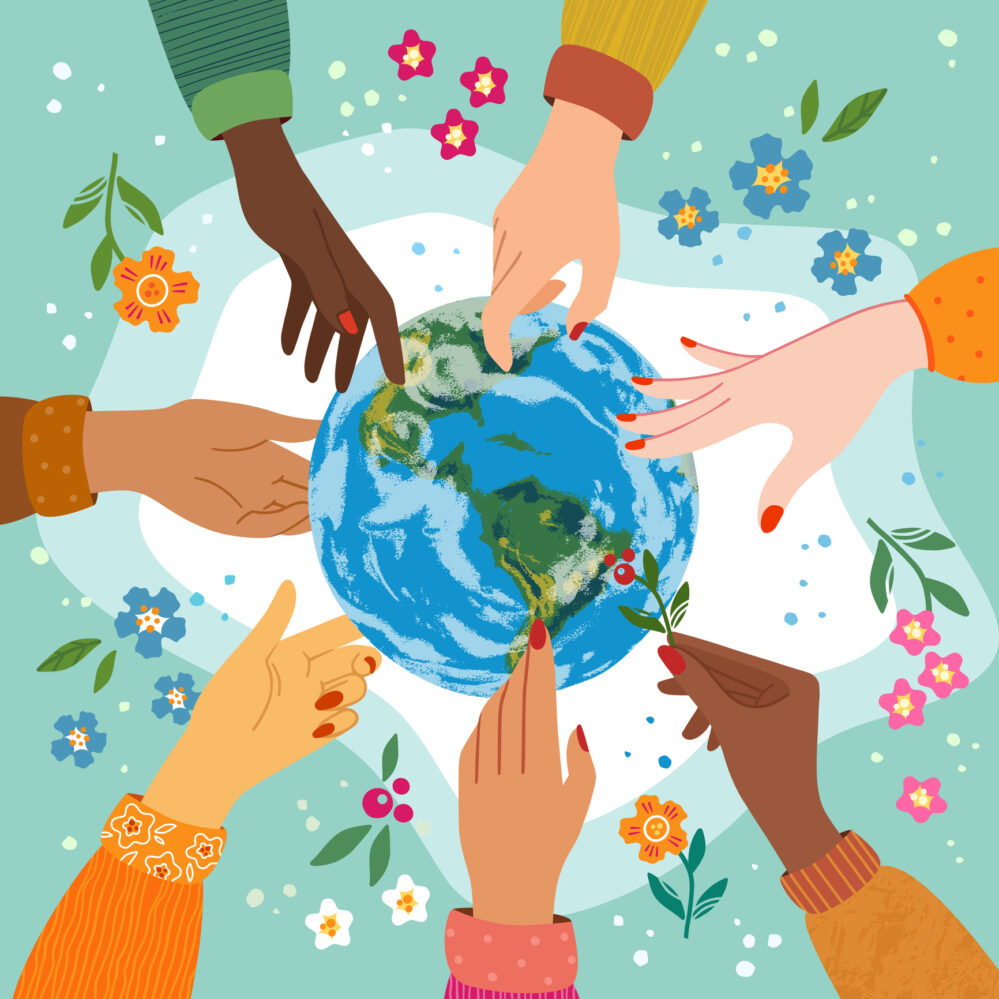
Climate change continues to be one of the greatest challenges facing humanity. Natural disasters are becoming more frequent and intense: a recent UN report suggested that by 2030, the world will experience over 500 major disaster events—such as storms, heatwaves, floods, and droughts—each year. That’s more than one sudden disaster event per day. Slow-onset phenomenons, such as increasing temperatures and sea-level rise, are also worsening and making life unsustainable for humans.
The impacts of climate change are not felt equally. Climate change disproportionately affects already disadvantaged groups and deepens historic and ongoing global inequalities. Furthermore, climate change hasn’t happened on its own: humanity has contributed to rising temperatures and changing climate patterns. Assessments by the Intergovernmental Panel on Climate Change (IPPC), which is the world’s principal scientific body on climate change, have made it clear that human activities are the main drivers of climate change and have accelerated the planet’s warming. Climate change is already causing dangerous and widespread disruption to billions of people worldwide. In the United States, a historic heatwave in the Pacific Northwest resulted in extreme temperatures and killed nearly 200 people in Oregon and Washington. Across Central America, extreme weather events affected 8 million people and increased food insecurity.
Globally, millions have also been forced to move due to the impact of climate change. An average of 21.5 million people have been displaced annually by weather emergencies since 2010. The IPPC report “Climate Change 2022: Impacts, Adaptation and Vulnerability” makes it clear that climate change is altering patterns, and becoming a major driver, of human migration. While it is projected that many people will be displaced within their own borders, people will also be displaced across borders. The IPPC report also acknowledges that making precise predictions about how many people will migrate due to climate change is difficult. While climate change is just one of many drivers of human migration—economic, social, and many other factors also play a role—the IPCC report makes it clear that migration is increasingly becoming a form of climate adaptation. Even though there have been significant mitigation efforts (such as reducing greenhouse gas emissions), many of the impacts of global warming are irreversible. People will simply have to adapt to a new reality and respond accordingly. Climate adaptation is the process of adjustment that individuals undergo in order to reduce the negative impacts of climate change while taking advantage of new opportunities. Adaptation is vital to reducing the harm from climate change, and cannot be avoided: if someone’s home goes underwater, it isn’t reasonable to expect them to stay.
As the largest historical emitter of carbon emissions, the United States has a responsibility to address climate migration and acknowledge it as a form of adaptation. If people are already being forcibly displaced due to climate change, ensuring their journeys are safe and dignified will improve their chances of survival—as well as those of future generations of people forced to flee their homes due to climate change. In the United States, and internationally, there is no specific policy infrastructure in place to address climate migration, but in 2021 the Biden administration took a positive step by commissioning the “Report on the Impact of Climate Change on Migration.” The United States should continue to build on the momentum created by this groundbreaking report and take additional steps to ensure climate migrants are met with respect and dignity.
In recent years, there has been an increase in the number of policy advocacy organizations that are tackling climate migration (see our infographic here). This report is meant to build a foundational understanding of which organizations are working on climate migration and assess the strengths and opportunities for collaboration among them. Although there is a larger international movement and multilateral engagement is important, the scope of this landscape analysis is on policy advocacy organizations working within the United States for two reasons. First, the lack of a cohesive international response positions the United States to emerge as a policy leader on this emerging issue. Secondly, the United States is historically the largest contributor to climate change emissions and thus has an outsized responsibility to lead on the important work of dealing with the impacts of climate change, including human migration.
What is the difference? “Climate displaced” vs. “climate migrant” vs. “climate refugee”There is no legal definition or internationally accepted term when discussing a person impacted by the climate–migration nexus.
Among policy advocates and organizers, the following terms are used:
This report uses the term climate migration to encompass forced and voluntary, temporary and permanent, internal and cross-border climate-related movement caused by sudden-onset events (storms) or slow-onset processes (sea-level rise, increasing temperatures). Using climate instead of environmental puts the onus on human-induced climate change. It is meant to be an all-encompassing term to signal that whether people are forcibly displaced or decide it is what is best for their families, they all deserve a safe and dignified way to migrate.
|
Policy advocacy organizations have an important role to play in the climate migration movement.
Any policy solution that helps address climate migration will need to be rooted in dignity and justice, but that basis won’t develop on its own. It will require a unified vision and a collective effort to push for the humane treatment of all migrants, including climate migrants. Policy advocacy organizations have a big role to play in this field.
In their 2021 Civil Society Report, CIVICUS, a global civil society alliance that comprises a network of organizations at the local, national, regional, and international levels, makes the case that political leaders will not act on climate change at the scale required without civil society, which includes policy advocacy organizations, keeping up the pressure. The same is also true for climate migration, which is just one extension of the impacts of climate change. While some policy advocacy organizations have initiated efforts to collaborate on climate migration, there is no coordinated approach or agreed-upon solution for how the United States can address the impact climate change has on human migration. Policy advocacy organizations working within the United States have an opportunity to influence and advance the U.S. response to climate migration and ensure that it is an equitable, just, and thoughtful response that centers the dignity of the individuals and communities who will be disproportionately impacted by climate change.
The climate crisis is already impacting communities globally, including in the United States. Every day of inaction creates greater urgency for equitable policy solutions that address climate migration and for collaboration at the intersection of migration and climate change. Cross-collaboration is needed to help climate migration policies gain much-needed momentum.
View full infographic here
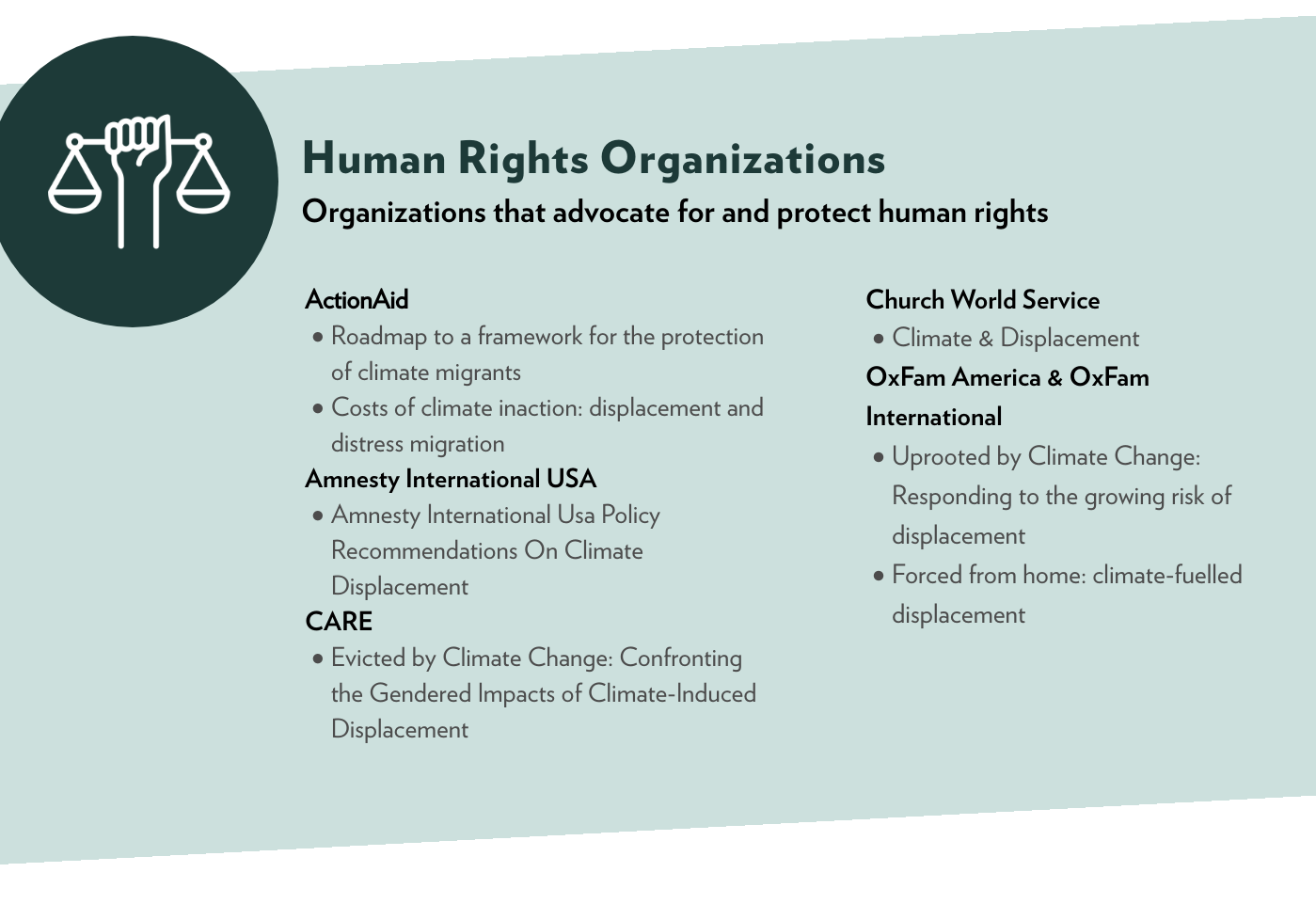
The Status Quo: Policymakers’ energy and enthusiasm for working on climate migration ebbs and flows.
International Refugee Assistance Project (IRAP), an organization focused on policy advocacy and providing legal services to refugees, has identified a key challenge in climate migration work: climate migration is framed as a problem of the distant future, and therefore is often deprioritized by policymakers when other crises occur.
In February 2021, President Biden requested a report on climate change and its impact on migration in Executive Order 14013, “Rebuilding and Enhancing Programs to Resettle Refugees and Planning for the Impact of Climate Change on Migration.” At the time, there was a burst of energy and enthusiasm from the administration as they engaged stakeholders who published recommendations to inform the report. The White House released its “Report on the Impact of Climate Change on Migration” in October 2021, the first report by any U.S. administration to outline the inextricable links between climate change and migration. Although the report was light on concrete next steps, it established the Standing Interagency Policy Process (“interagency working group”) on Climate Change and Migration to “coordinate U.S. government efforts to mitigate and respond to migration resulting from the impacts of climate change.” Since the release of the report nearly a year ago, there hasn’t been any further public policy action taken on climate migration from the Biden administration.
Climate migration is framed as a problem of the distant future, and therefore is often deprioritized by policymakers when other crises occur.
Congressional action has also been limited. In 2019, Senator Edward Markey (D-MA) introduced “To establish a Global Climate Change Resilience Strategy, to authorize the admission of climate-displaced persons,” and for other purposes in the Senate (S.2565), and Representative Nydia Velázquez (D-NY) introduced a version in the House (H.R.4732), but neither were ever brought to a vote. The bills were re-introduced in 2021 with updated language (S.1335 and H.R.2826), but remain unlikely to be voted on anytime soon. The bill would establish a national strategy to address climate displacement by creating a U.S. resettlement pathway for climate-displaced persons. It would also establish a global climate change resiliency strategy to guide U.S. government policy and programming, create a government-wide coordinator for climate resilience position, and provide training for Foreign Service officers in climate change resilience.
Despite the lack of recent action, policy advocacy organizations have continued to engage policymakers and the public to raise awareness of the issue. A leading group of thirteen organizations were part of an effort to push the national security advisor to provide further clarity on the interagency working group. Unfortunately, there has been no response from governmental officials to that request. Organizations must continue to keep the Biden administration and all policymakers accountable so the United States can start addressing this issue in a timely and equitable manner.
View full infographic here
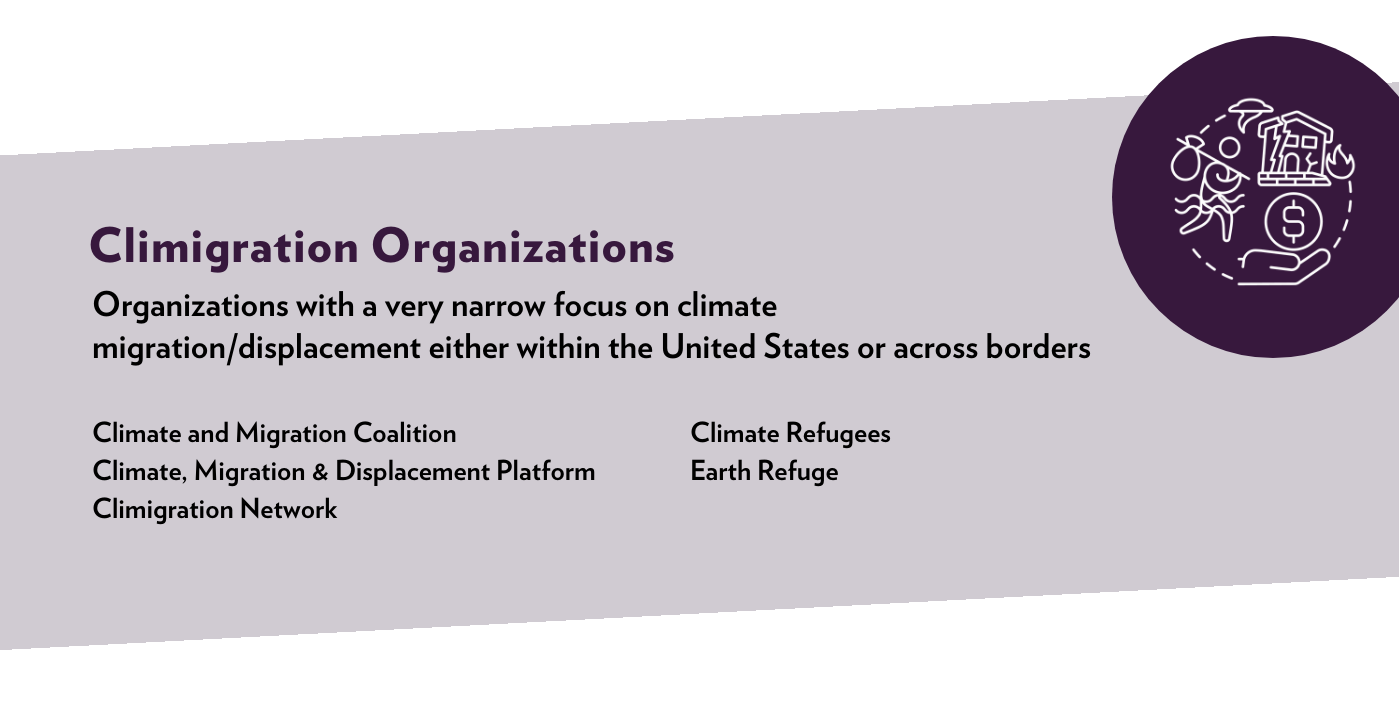
Policy advocacy organizations’ impact on climate migration is limited, but can be increased through collaboration and increased funding.
limate migration is a growing issue that needs broad, collective support. The climate–migration nexus is currently a niche topic to which only a few organizations have been able to dedicate resources. Organizational leaders in the space have done crucial work with limited capacities, such as pinpointing immediate policy interventions that the Biden administration can move on to protect climate migrants now (e.g. expanding Temporary Protected Status). But there needs to be a broader movement to push for solutions. While there is consensus among organizations that climate migration should be addressed in a just and humane way, the lack of resources and attention on climate migration has limited progress in making the United States a global leader on this issue. One possible solution is to continue and deepen cross-sector collaboration between climate and immigrant justice organizations to build strength and capacity together. Each sector has expertise, connections, allies, and access to funding that the other might not have.
In the past decade, Undocumented youth have become a powerful, political voice in the immigrant justice movement. From the DREAM Act to DACA and deportation defense, Undocumented organizers have shaped policies, influenced elections, and sparked national conversations about exclusion and belonging. Climate justice organizations increasingly recognize the need to form solutions alongside impacted communities as part of their work and, through collaboration on climate migration with immigration organizations, they will learn how to better center impacted populations from immigrant justice organizations.
The immigrant justice movement has only recently started collectively acknowledging and grappling with how the climate crisis will impact human migration and the immigrant communities already present in the United States. Climate justice organizations have a wealth of knowledge and understanding about climate change that could guide immigration organizations. Both climate and immigrant justice organizations are increasingly recognizing that solutions must be rooted in racial justice to address the issues equitably. They can support each other in this endeavor. They both also have a rich history of direct action that makes them good partners from a strategic point of view. Although both movements are just starting to recognize climate migration, both deeply value that all migrants, regardless of why they move, deserve to live a dignified life.
Currently, the efforts to work on the intersection of climate and immigration justice are limited, but promising partnerships are underway. Stephanie Teatro, director of climate justice and migration for National Partnership for New Americans (NPNA), put it this way:
I feel excited about the field of organizations that are emerging and working together and looking at this issue. Increasingly in both the immigrant rights movement and the climate justice movement is the recognition that we need to work together to address climate change and climate migration and to advocate for migration as a key solution and adaptation.
Currently, NPNA is at the forefront of that intersectionality, having established a new Climate Justice Collaborative to act as a hub. The hub is meant to increase the capacity of local immigrant justice organizations to engage in climate justice campaigns and influence the climate movement and national climate conversations, develop greater alignment between the climate and immigrant justice movements, and build broad support for expanded, safe pathways for climate migration. .
IRAP is another organization that is seriously considering how to engage more with climate justice issues. It has developed its Climate Displacement Program with guidance from the Natural Resources Defense Council (NRDC). IRAP and NRDC have a cross-sector partnership that has increased the capacity of IRAP to support climate migrants and develop effective advocacy, thereby quickly making them leaders in the climate migration space. IRAP recognizes, however, that this kind of collaboration is still uncommon: immigrant and climate justice work largely tends to happen in silos with cross-sector organizations rarely speaking to each other. This is why IRAP, in partnership with 350.org and the ACLU of Southern California, put together a three-part convening in the summer of 2021 where environmental, immigration, and refugee advocates could share knowledge, strengthen relationships, and develop strategies to address climate displacement. More information sharing and collaborative spaces like this are needed for a collective movement to emerge.
Another example of cross-sector collaboration is the partnership between United We Dream (UWD) and the Sunrise Movement, two powerful youth-led organizations, who joined forces to demand stronger protections for immigrants and the climate in the Build Back Better plan. While UWD sees its work as intersectional and knows that its membership deeply cares about climate change, deputy director of federal advocacy for UWD, Juliana Macedo do Nascimento recognizes the challenge:
This hits against a capacity issue, right? Because as big as we are, for example, the federal advocacy team is me and another person. So we want to do everything, but we have to figure out what we can do.
However, UWD is committed to continuing to work with the Sunrise Movement to make this a salient, top-of-mind issue for their membership and the general public. This collaboration is an example that working together can increase the capacity of organizations to work on this issue.
Other collaborative efforts include Friends of the Earth US (FoEUS) partnering with the Transnational Institute to publish a brief illustrating how the biggest asset management firms fuel and profit from the climate crisis and border militarization. FoEUS also partnered with Mijente for a campaign to urge Blackrock—the world’s largest asset manager— to divest from deportation enforcement by not funding Palantir, a data analytics company that provides technology to Immigration and Customs Enforcement (ICE) that is used to target immigrants, refugees, and asylum-seekers for detention and deportation.
Further work at the intersection of climate and migration justice is critical to ensure that climate migrants are met with dignity and respect.
Yet another example of cross-sector collaboration is the Southern Border Communities Coalition joining forces with the Sierra Club to advocate against the militarization of the southern border; they even filed a lawsuit challenging the border wall construction in 2019 with the help of the American Civil Rights Union (ACLU).
These are just a few of the promising efforts underway. For further collaborative efforts, there needs to be an increase in resources for organizations. Unbound Philanthropy recognizes this and is attempting to prompt further intersectional work by publishing “On the Frontlines of the Climate Emergency: Where Immigrants Meet Climate Change,” a report to inform funders about the “impact of the climate crisis on global migration and immigrant communities in the United States, and to inspire philanthropy to accelerate investment in the organizations and leaders who are stepping up to meet urgent, interconnected challenges with innovative solutions.” The report provides an entry point to funders and concrete steps to take action.
Further work at the intersection of climate and migration justice is critical to ensure that climate migrants are met with dignity and respect.
View full infographic here

There needs to be a reframing of climate migration to ensure policy responses are more equitable and human-centered.
The current shock-factor narratives about climate migration portrayed in the media feed into dangerous xenophobic political rhetoric and lead to enforcement and militarized policies. These narratives have been pushed for years. Since its first assessments in the 1990s, IPPC noted that “the gravest effects of climate change may be those on human migration as millions are displaced by shoreline erosion, coastal flooding and severe drought.” Although not inherently dangerous, the narrative that migration will be the biggest human consequence of the climate crisis has been peddled by certain groups with fear and suspicion as the result, rather than empathy and meaningful action.
Historically, the environmental movement in the United States has been rooted in racism and exclusion. The current mainstream climate movement has increasingly moved away from its racist past and is making a concerted effort to be anti-racist and increasingly build a multi-racial movement; however, climate justice organizations have continued their harmful practice of echoing predictions of large-scale climate migration and using shock-factor narratives with the belief that doing so will prompt a government response on climate change, despite no evidence to support the notion that concerns for displaced people lead to concerted climate action. Furthermore, there are no conclusive data on future estimates of climate migration. Predictions and estimates have become a contentious issue in debates on climate migration and vary wildly depending on the study, from 200 million to 1 billion by 2050. The wide variability in predictions can be harmful when they are weaponized by anti-immigrant, and far-right ideologies.
Anti-immigrant groups and political trends continue to embrace the racist narratives of the nineteenth-century American environmental movement and make xenophobic claims that immigration is to blame for America’s environmental problems. They use language like “mass migration” and “unprecedented migration” and cite future predictions to stoke fear of uncontrolled migration. The media and government officials have amplified those narratives and depict climate migrants as threatening. It has triggered fear, fueling further xenophobic narratives that dehumanize migrants. This dangerous rhetoric can, and often does, lead to racial violence.
The security establishment has taken advantage of the othering of climate migrants and has used the future “threat” of mass climate migration to frame climate change through a national and international security lens. Focusing on “alarming” future predictions of climate migrants has also led to the world’s wealthiest nations prioritizing border militarization over climate action. The United States spends $19.6 billion on border and immigration enforcement, eleven times more than the $1.8 billion it has spent on climate finance between 2013 and 2018.
Many organizations have demonstrated there are better ways to talk about climate migration. A collaboration between Pacific Islands Students Fighting Climate Change, 350.org, FoEUS, Institute for Policy Studies, and Climate and Migration Coalition resulted in “How to Communicate About Climate Linked Mobility,” a brief for climate communicators on how to avoid the dangerous climate narratives.
Other efforts to change the narrative about climate migration include the work of the Climate Justice Collaborative, led by NPNA, to develop narratives that normalize migration as an adaptation tool in the face of dangerous climate disasters and uplift immigrant communities. NPNA partnered with Communities United for Status and Protection (CUSP), IRAP, and Refugees International on a messaging guide for organizations and advocates to use when responding to disasters within the United States. The Climigration Network also generated Lead With Listening: A Guidebook For Community Conversations on Climate Migration in hopes of getting more communities to start having conversations about climate migration within the United States.
All of these efforts remind us that migration is an adaptive response to man-made threats, not a threat itself. The real threat is the inaction of the fossil fuel industry and politicians who continue to deny climate change and its impacts. While it is white nationalist, far-right groups that most visibly continue to peddle harmful narratives about migrants, it is also state actors that perpetuate the narrative and weaponize those narratives to drive policy responses that do not address the root cause of these problems. Furthermore, immigrants, refugees, and asylum seekers strengthen U.S. security by making communities safer and contribute billions of dollars each year to the economy through consumer spending and business start-ups. There needs to be continued efforts to disrupt the on-going harmful narratives and instead focus on humanizing climate migrants by centering their stories and highlighting their resiliency. It is imperative to have a people-centered narrative and policy solutions that are rooted in dignity and respect.
View full infographic here
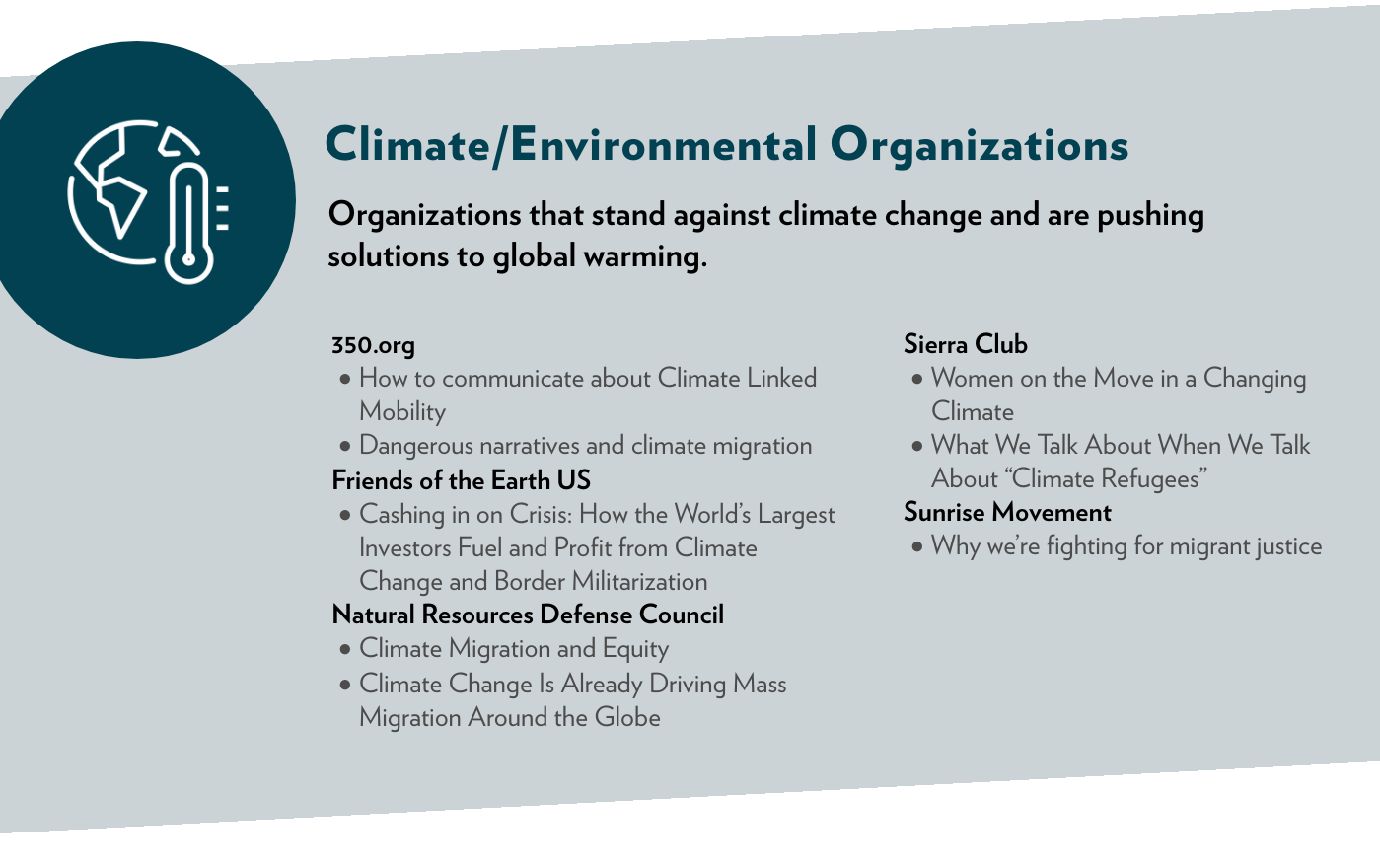
Directly impacted communities should be engaged in the climate migration work.
For any policy work it is important to engage impacted communities and this kind of engagement is critical for climate migration policy to be effective and meaningful. While climate change will harm all communities, Black, Indigenous, People of Color (BIPOC) and low-income communities in the United States are already being negatively impacted and will continue to be hit the hardest by climate impacts. Globally, the countries that have contributed the least to climate change are the most disproportionately impacted by severe climate risks. Gender also shapes the experiences, causes, and consequences of climate migration. Gender norms (division of labor, rights to assets, and access to decision-making) influence who moves and who stays. Oftentimes, climate change also exposes women to an increased risk of violence, trafficking, and conflict. However, women are already in both formal and informal roles of leadership. They are more likely than men to coordinate community movements, adaptation to climate impacts, and recovery from disasters. Because of this, women are well positioned to inform policy research and development.
Communities already live through this crisis, yet directly impacted communities are often excluded from policy research and development. In the Inclusive Policy Research and Policy Development with Impacted Communities toolkit, Next100 mentions the following: “Nowhere is the exclusion of directly impacted communities more indefensible than in our democracy and policymaking process, the precise forums where decisions are made about how to prioritize, develop, and implement the solutions to our collective problems.” Directly impacted communities bring wisdom and invaluable insights from their lived experiences and should be a part of tackling this problem head on.
Sometimes the impacts of climate change are clear: for instance, hurricanes and droughts have become more intense and frequent. However, the impacts of climate change can also be harder to detect, such as with slow on-set challenges like weakened agricultural and ecological systems that threaten the food and economic opportunities that humans depend on, thereby making life unsustainable.
Both NPNA and IRAP are trying to grapple with how people who have experienced climate events see it as part of their migration story, especially since it’s not always so apparent when people experience the consequences of slow-onset climatic change. Regardless, both organizations understand the importance of engaging impacted individuals and centering them in their work.
Directly impacted communities bring wisdom and invaluable insights from their lived experiences and should be a part of tackling this problem head on.
As a representative for UWD, Juliana Macedo do Nascimento recognizes the stories of impacted individuals are important because stories of immigrant youth have the power to make climate migration a truly global issue, and youth have always been at the forefront of progressive movements. In her op-ed “Why Immigrant Youth Should Lead Climate Change Strikes,” she calls for immigrant youth to be at the frontlines of climate justice efforts.
Unitarian Universalist Service Committee (UUSC) also recognizes the importance of impacted communities. In 2018, in partnership with other organizations, they held the First Peoples’ Convening on Climate-Forced Displacement, a first-of-its-kind gathering. Salote Soqo, the director of advocacy and global displacement at UUSC, put it this way:
We brought together communities who are experiencing the same thing into the room, and despite the geographic differences, they shared one story…there was a recognition that almost everyone in that room had lost something because of climate change, even though the impacts were different in the different regions. They all had already moved once within the past thirty, forty years because of an environmental change and recognized that they needed to move within the next few decades as well.
It can be powerful when impacted communities come together, share their stories, and develop solutions they want to see. As people see the commonalities in their experiences, they’re on a path to building collective power to address this issue. Which is what is needed to push policy solutions forward.
Although there are some efforts to engage directly impacted communities, there need to be additional efforts. Their lived experiences will not only strengthen policy research and policy development for climate migration, but also create equitable and dignified solutions for climate migration.
View full infographic here
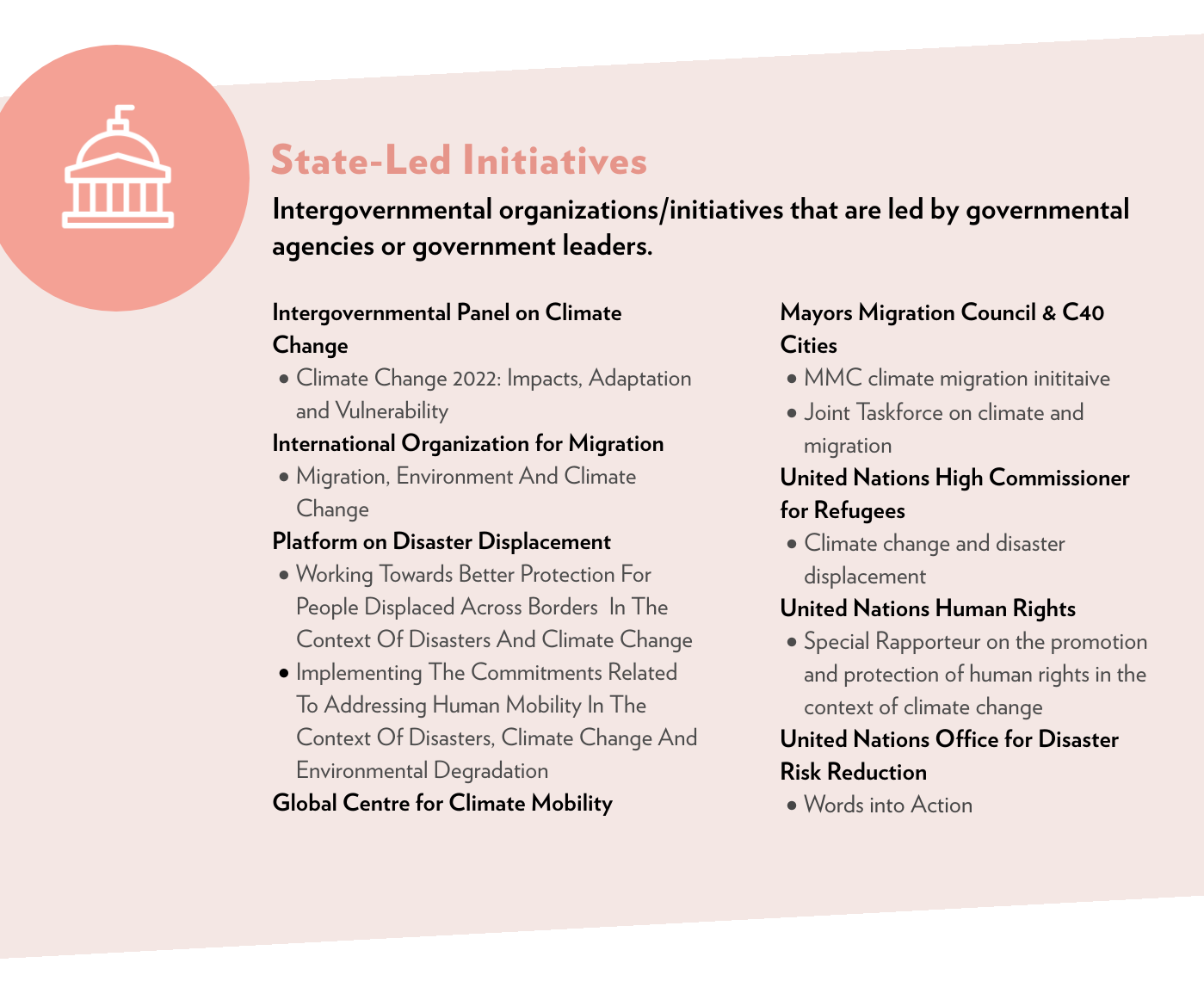
There needs to be an increase in qualitative studies and a greater alignment between research, policy development, and lived experiences.
Accurate data enables the development of evidence-based policies for climate migration. Researchers are key collaborators to policy advocacy organizations since policymakers like to be able to “put a number” and have forecasts when it comes to the issue. Yet quantification of human migration in the context of climate change is difficult. Despite the growing interest and a growing body of research, there are key challenges to “putting a number” to the issue— aside from the narrative perspective mentioned earlier. While some estimates suggest that between 200 million and 1 billion people could be displaced by climate change during the next 30 years, such figures are often based on guesswork. There is a lack of consistent and comparable data and reliable global data on migration to understand the scale of climate migration fully. There is also a lack of a clear definition of what characterizes a climate migrant and a coherent methodology when assessing climate impacts on migration. An international standardized framework that is humane-centered is needed to strengthen evidence to inform equitable public policy. Part of the framework is a concerted research effort using a range of methods– from quantitative to qualitative studies. There also needs to be greater agreement between definitions.
But more quantitative data and research alone won’t lead to equitable policy outcomes. Quantitative methods emphasize numbers and statistical or numerical models, but it misses the human aspect of climate migration which qualitative studies can help fill. Through interviews and focus groups, we can ensure the perspectives and experiences of impacted populations are centered in policy solutions. Although there is a limited number of qualitative studies on the subject, Moving Towards Resilience: A Study of Climate Change, Adaption and Migration is an excellent example of a qualitative study published by Church World Service (CWS) — a global faith-based organization that focuses on just and sustainable responses to hunger, poverty, displacement, and disaster. The study describes how people in Cambodia, Georgia (the country), Haiti, Indonesia, and Kenya feel climate change in their daily lives. The interviewees share how people want to stay in their homes and what additional resources they need to be able to do that, but others describe how migration is a way to cope with climate change. A man from Haiti shared: “Changes in the weather are causing everyone to want to run and leave the country. This means that we will cross the ocean no matter how rough it is, just to get out of here. A lot of people had no intention to leave. Now they can’t find anything that encourages them to stay.” They share their experiences but they also offer practical suggestions for making migration safer. CWS was uniquely positioned to carry out the study because they have built relationships with the communities over the years through their work.
Qualitative research helps ground the numbers so it is not forgotten that it is human beings that are experiencing this. It provides insight into ‘why’ people migrate, not just ‘how many’. But again, greater alignment and collaboration between researchers, policymakers, policy advocacy organizations, and people with lived experiences is needed. There needs to be a greater integration of people with lived experiences into climate migration research, their experiences could bring new approaches and better inform policies and qualitative studies is a way to do this.
View full infographic here

How to Move the Needle on Climate Migration
While there is a consensus that climate migration should be addressed justly and humanely, there needs to be a continued united effort to move the work forward and push for the United States to become a leader on this issue. It is up to public advocacy organizations to continue to pressure policymakers so they can start addressing this issue in a timely and equitable manner. While there have been a lot of great efforts from organizations at the nexus of climate change and migration, there is still a lot to do to ensure the Biden administration and other policymakers take climate migration seriously. As existing organizations continue their work and new actors prepare to engage, all involved must work together to build on efforts that are already underway.
While there is a consensus that climate migration should be addressed justly and humanely, there needs to be a continued united effort to move the work forward and push for the United States to become a leader on this issue
As organizations coordinate and work together, there needs to be a cohesive demand to push the Biden administration and policymakers to create equitable and just solutions for climate migrants. Climate and immigration justice organizations can work together to demand that policymakers do the following:
1. Increase transparency on the efforts the government is taking to address climate migration.
The Biden administration has already shown interest in climate migration by commissioning the Report on the Impact of Climate Change on Migration and establishing the interagency working group. The next step in their commitment is to ensure work on this issue is transparent. It is easy for this issue to be pushed to the wayside if it is seen as a future problem, but it is happening now, so the administration should act accordingly. While the interagency working group represents an important first step, there needs to be a more permanent and sustained effort within government to address climate change. Specifically, the Biden administration should establish a coordinator for climate migration that does not operate within a law enforcement agency. The coordinator would provide the foundation for a full government and policy response to an emerging issue that is in need of humane and equitable attention. The administration should also provide more transparency on current government efforts to address climate migration. Since the interagency group was announced, there has been no transparency about where the interagency workgroup stands. Without transparency, organizations are unable to ensure that the issue is being addressed equitably and humanely.
2. Follow the lead of advocacy organizations and include directly impacted communities in shaping the policy response.
There are a few organizations that have been working on climate migration in collaboration with communities that have been displaced because of climate change, such as UUSC. And yet the administration only briefly consulted these organizations for the Report on the Impact of Climate Change on Migration, not making full use of the capacity and expertise that is at their disposal. There needs to be continued and consistent meaningful engagement with these organizations while also conferring with directly impacted communities. Consulting with organizations and communities can help the administration improve how they address climate migration, thereby shifting the narrative and policies from solely a national security lens to a human-centered approach. Engaging organizations and communities is important because when they are involved, solutions are more likely to be dignified and just. Organizations also already have concrete policy solutions for climate migration that the administration can implement, such as expanding Temporary Protected Status, expanding humanitarian parole protections, and creating a system of complementary protection in parallel with the U.S. Refugee Admissions Program. All of these options provide different levels of relief and different pathways for the Biden administration to start addressing the issue and policymakers should not be afraid to use every tool available to them.
3. Increase research and data collection on people’s lived experiences with climate migration.
While climate migration isn’t anything new, it is a policy area that is just starting to get the attention it needs. While work has been done to gather information on the issue, there is still a lot we don’t know, especially when it comes to people’s lived experiences. If we want to build a humane, just framework, we need to understand people’s experiences. Quantitative data is not enough, especially when projections of climate migration can vary. An important step to truly understand the issue is to gather more qualitative data. This is a gap in the climate migration space, and without it, there won’t be sufficient alignment between what communities need and policy solutions. Organizations have built trust with communities and are uniquely positioned to do interviews and focus groups, but their resources are limited. The government has more resources and greater ability to create a systemic methodology. The administration should work more closely with organizations to increase research and data collection to understand the full impact of climate migration.
These are initial steps that organizations should be pushing for from the Biden administration and other policymakers. There’s a dignified, just way forward to address climate migration, but government, organizations, and communities need to work together to start moving the needle. Climate change and climate migration are such complex issues that we all need to work collectively if we want to address them effectively and humanely.

